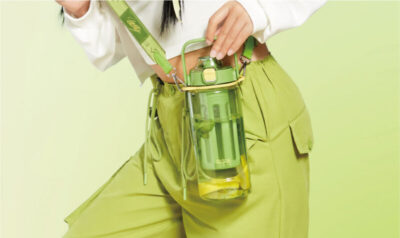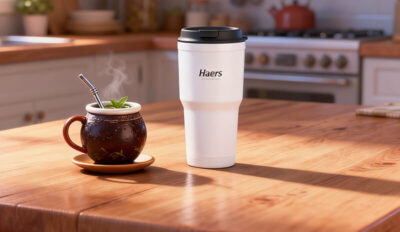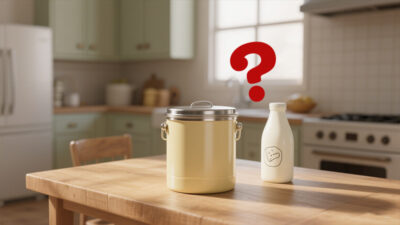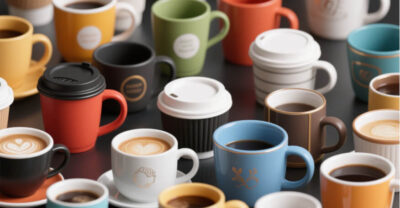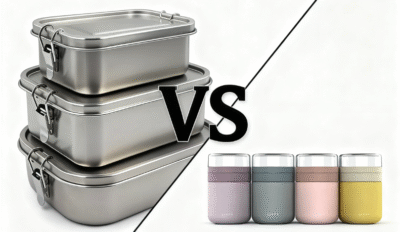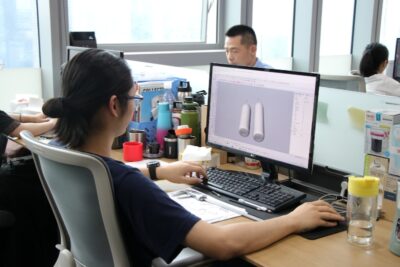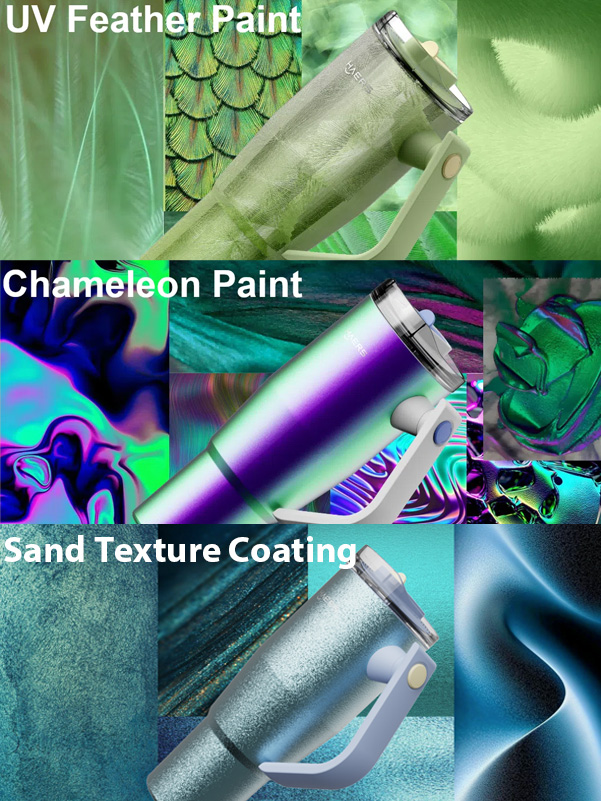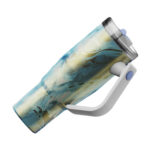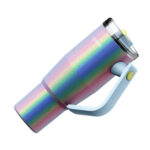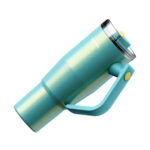Powder Coating vs. UV Printing: Which Is More Wear-Resistant?
Stainless steel insulated bottles have become more than just functional containers for keeping drinks hot or cold. Consumers now also care about how the product looks—and how well that look holds up over time. For brand retailers, choosing the right surface finishing method helps reduce customer complaints and boosts product appeal in a competitive market.
Among the most common surface treatments, powder coating and UV printing each have their own strengths. Powder coating creates a durable protective layer through high-temperature curing, while UV printing offers high-definition graphics using fast-drying ink. But which one performs better in terms of durability when brands want to custom water bottles? And in what situations does each method work best?
Table of Contents
ToggleWhat Is Powder Coating?
Powder coating is a popular surface finishing process often used on stainless steel insulated bottles and other metal products. It works by using an electrostatic field to charge powder particles, which are then evenly attracted to the metal surface. The coated bottle is baked at high temperatures—typically between 180°C and 220°C—so the powder melts, bonds tightly to the surface, and forms a smooth, solid layer as it cools.

Before spraying, the bottle goes through pretreatment steps like cleaning and sanding to remove oil, dust, or other contaminants. This improves the adhesion of the powder. Then, an electrostatic spray gun evenly applies the powder, and the coated bottle is placed in a curing oven to set the coating fully.
Powder coating offers several key benefits:
Excellent wear resistance: The cured layer bonds tightly to the bottle, forming a tough shield against scratches, bumps, and general wear. Even with regular use, the coating maintains its integrity and appearance.
Strong corrosion resistance: It protects against acids and alkalis in drinks, moisture in the air, and exposure to chemicals, helping extend the bottle’s service life.
Good weather resistance: The coating remains stable under various temperature and humidity conditions.
Visually, powder-coated finishes offer full, even color with a soft matte effect. The surface looks smooth under all lighting conditions, with no major color or gloss variation. To the touch, the finish feels fine-textured and dry—not rough or sticky—offering a solid, reliable grip. This gives the bottle a clean, understated, and premium feel.
What Is UV Printing?
UV stands for ultraviolet, and UV printing is a digital surface printing process that uses ultraviolet light to instantly cure specially formulated inks applied to the bottle’s surface, forming text or graphic patterns. The ink contains photoinitiators that, when exposed to UV light, trigger a polymerization reaction among the ink’s active monomers and oligomers. This causes the ink to harden immediately from liquid to solid, adhering firmly to the cup surface.
The process is typically carried out using a UV printer. The desired design is first set up on a computer, then the printer’s nozzles precisely spray the ink onto the bottle. At the same time, UV lamps shine light on the ink in real-time, allowing it to cure instantly as it’s printed.
UV printing stands out for its exceptional flexibility and image quality.
High-resolution detailing: It can accurately reproduce very fine patterns, intricate lines, and even tiny text with sharp clarity.
Vivid colors: With a wide color gamut, UV printing delivers vibrant, eye-catching designs that make a strong visual impact.
Fast turnaround: Since it’s a digital process, it’s ideal for short production runs and even one-off personalized designs, offering great flexibility with quick delivery times.
In terms of appearance, UV-printed designs are bright and visually striking, almost as if the artwork is painted directly onto the cup. The details are crisp, with sharp edges and no smudging or blurring. The surface feels smooth to the touch, and while you can feel the print slightly, it has no raised or sunken texture. The finish is sleek and stylish, making it particularly appealing to consumers who value uniqueness and artistic flair.
Which Is More Wear-Resistant: Powder Coating or UV Printing?
When customizing a water bottle, wear resistance plays a key role in determining how well the exterior finish holds up over time. This durability largely depends on the structure and physical properties of the surface coating. Although both powder coating and UV printing serve decorative purposes, they differ significantly in wear resistance due to the fundamental differences in how their coatings are formed.
1. Wear Resistance of Powder Coating
Powder coating uses electrostatic forces to evenly apply solid powder to the bottle surface, which is then cured at high temperatures to form a dense coating around 60–100 microns thick. Unlike a simple surface layer, this coating is the result of powder particles melting and flowing into a tightly bonded film during the curing process. This gives powder coating two key strengths when it comes to resisting wear: high hardness and strong adhesion.
In terms of hardness, powder-coated surfaces can effectively withstand scratches from common sharp objects like keys or cutlery. The relatively thick coating also acts as a cushioning barrier—when the bottle experiences friction or impact, the layer absorbs part of the force through minor deformation, reducing direct damage to the surface.
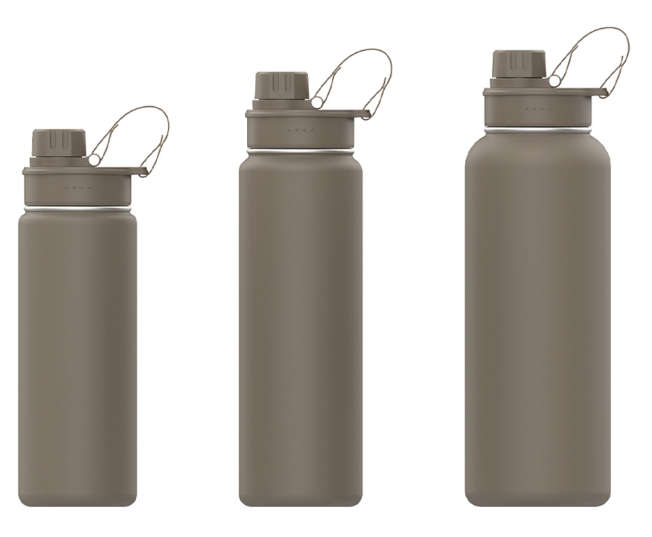
2. Wear Characteristics of UV Printing
UV printing forms its coating through the rapid curing of ink on the bottle surface using ultraviolet light. The cured layer is much thinner—typically just 5–15 microns thick, about one-tenth the thickness of powder coating. Since the ink only adheres to the surface through a fast polymerization reaction, it has some inherent disadvantages in wear resistance: lower hardness and more dependence on surface preparation.
UV ink is softer than powder coating and more prone to scratches from sharp objects. Edges of printed designs are especially vulnerable to fading or chipping. Due to the thinness of the layer, repeated friction—such as sliding the bottle on a rough surface—can gradually wear away the print, exposing the underlying metal
. 
Additionally, the strength of UV print adhesion depends heavily on how well the bottle is pretreated. If the surface isn’t properly cleaned or the curing is incomplete, even minor friction can cause the design to peel off. This issue is more pronounced on curved surfaces, where tension is uneven, especially around the edges of the bottle.
Cost and Customization Flexibility
When choosing a surface treatment for stainless steel insulated tumblers, cost efficiency and customization flexibility are two critical factors for brand retailers. Due to their different technical principles and production methods, powder coating and UV printing offer distinct advantages and trade-offs in both cost structure and adaptability to customized designs.
1. Cost Comparison
Powder coating is most cost-effective in large-scale production scenarios. It involves relatively high upfront investment—such as electrostatic spraying equipment, high-temperature curing ovens, and bulk powder procurement. However, as production volume increases, fixed costs are spread across more units, leading to significant economies of scale. For standardized or regular product lines produced in high volumes, powder coating allows for low per-unit coating costs.
That said, powder coating becomes less cost-efficient for small orders (under 1,000 units). Changing powder colors or surface textures requires equipment cleaning and parameter adjustments, which incur additional time, material waste, and operational costs—potentially making powder coating even more expensive than UV printing for small batches.
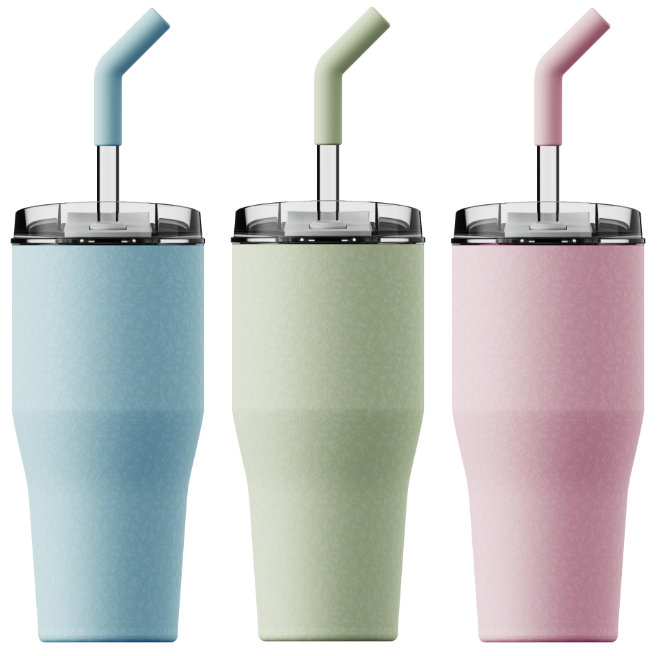
UV printing, on the other hand, shines in low-volume production and fast design iterations. While the initial investment in equipment is relatively high, it requires no physical molds. Designs can be easily updated via digital files, and the marginal cost does not increase significantly with each new pattern. For small runs—ranging from a single item to a few hundred—UV printing can be much more cost-effective, as it eliminates the need to store multiple powder types and minimizes material waste through precise ink usage.
However, UV ink is significantly more expensive than powder. Once production scales up to tens of thousands of units, the total ink consumption drives up unit costs considerably. When manufacturing large-scale water bottles, powder coating’s cost advantage reemerges.
For brand retailers, if the goal is to offer standardized products for mass-market distribution, powder coating offers a balance of quality and cost savings. Meanwhile, UV printing—with higher material costs—makes more sense for limited editions or small batch personalized bottles, where higher perceived value can offset the increased expense.
2. Customization Flexibility: Standardized Output vs. Personalized Appeal
The key strength of UV printing lies in its high customization flexibility. As a digital process, it uses software to precisely control the inkjet path, allowing for the reproduction of virtually any design—no matter how detailed or complex. Most importantly, UV printing is non-plate-based, meaning there’s no need to create physical molds for different designs. From design finalization to sample output, production can be completed within just a few hours.

This makes UV printing ideal for short-run, highly personalized promotional gifts, tailored to specific customer tastes. For example, brand retailers can launch seasonal or event-themed collections, updating designs quickly to match holidays, trends, or viral topics—adding freshness and marketing appeal.
In contrast, powder coating is better suited for standardized, less-variable designs. Its finish (such as color, gloss, or texture) depends on the physical properties of the powder. Adjusting the look requires switching powder formulations and recalibrating spraying parameters. Furthermore, powder coating is not designed for localized graphic customization, making it less suitable for intricate or pattern-specific personalization.
For value-driven mainstream brands, powder coating supports long-term cost control and a stable supply chain, helping reduce retail prices and gain market share. On the other hand, design-oriented premium brands can leverage UV printing’s customization power to create differentiated, standout products that appeal to style-conscious consumers. Even with higher production costs, the added brand value often justifies the price point.
Application Scenarios Differences
Due to their distinct technical characteristics, powder coating and UV printing serve different application needs and complement each other across a variety of use cases.
Powder coating excels in durability and environmental resilience, making it ideal for situations where wear resistance and frequent handling are required. For example, in outdoor commuting scenarios, insulated bottles often come into contact with rough surfaces like backpacks or rocks. The thick coating formed by powder spraying effectively resists abrasion. In industrial work environments, where collisions, grease, or corrosive elements are common, the corrosion resistance of powder-coated surfaces ensures long-term visual integrity.

For daily-use bottles aimed at mass markets, such as standard commuter mugs or sports bottles—powder coating is the preferred choice. These products emphasize balanced performance without weak points. Most consumers in this segment prioritize durability and long-term reliability over short-term aesthetics.
In contrast, UV printing is best suited for personalized design and scenario-based marketing. In the fashion consumer market, limited edition or co-branded bottles often rely on UV printing to enable quick pattern updates—featuring trending IPs, artwork, or seasonal themes that appeal to younger demographics and trigger impulse purchases.

In the promotional gift market, UV printing supports single-unit customization, allowing businesses to personalize bottles with logos, greetings, or even recipient names—enhancing the gift’s exclusivity and emotional value.
When it comes to high-frequency use or harsh environments, powder coating stands out as the most suitable choice. Its coating effectively withstands dust, friction, and impact damage, making it ideal for rugged or long-term use.
Meanwhile, UV-printed bottles are better suited for light indoor use or as short-term lifestyle accessories. This includes mugs used occasionally in office settings, or seasonal promotional products with lower wear exposure. In these contexts, the vibrant UV-printed graphics remain visually appealing over short periods. However, when exposed to prolonged friction or challenging environments, the printed surface may show signs of wear and fading over time.
Appearance Comparison
Powder coating delivers a minimalist and consistent aesthetic. Its high-temperature curing process forms a dense, uniform surface that typically features solid, matte finishes. Visually, it presents a flawless, understated look ideal for minimalist designs that emphasize function over embellishment. In terms of tactile feel, powder-coated bottles offer a delicate grainy texture, giving users a sense of sturdiness and durability—perfect for outdoor or business scenarios that prioritize functionality and reliability.
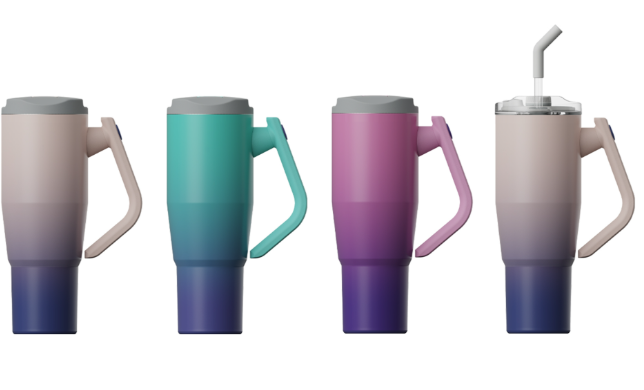
At Haers, powder coating is the default finish for most insulated bottles, especially in the absence of specific design requirements. This is because powder coating can deliver an even, durable solid-color finish at a lower cost, fulfilling the mainstream market’s demand for practicality, stain resistance, and versatility. In addition to basic matte finishes, Haers also offers special effect coatings like Rainbow, Algae, Snowflake, and Crackle, which enrich the aesthetic possibilities while retaining the core durability benefits. These finishes elevate powder-coated bottles closer to the realm of artistic craftsmanship.
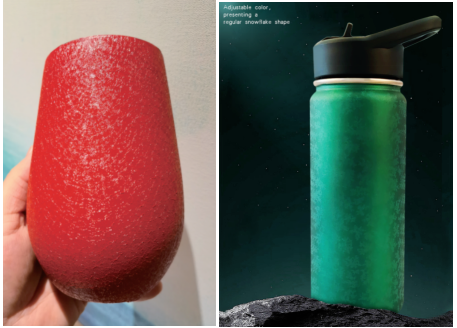
Haers’ powder coating process is highly mature, offering a broad color palette—from basic black, white, and grey to trendy Morandi tones—all accurately reproducible without extra color-matching effort. This makes powder coating the go-to choice for entry-level or all-purpose insulated bottles, where simplicity, adaptability, and long-term value are the primary concerns.
In contrast, UV printing shines in visual complexity and precision. It excels at rendering high-definition, full-color graphics with remarkable clarity—even gradients and fine text appear crisp and vivid. With the introduction of nano UV printing technology, product surfaces have taken a qualitative leap in design sophistication. Special UV techniques create unique textures and finishes by adjusting gloss and layering with custom UV primers and curing:
Sand texture mimics natural stone, enhancing premium appeal
Feather texture uses soft gradient lines for a gentle, elegant mood
Ice flower texture introduces organic crackle patterns, giving bottles an artistic flair
These effects go beyond surface beauty—each texture tells a material story and reflects the brand’s design strength.

While powder coating is rooted in minimalism and utility, UV printing caters to design-driven products. It is especially suited for bottles requiring fine details or vibrant visuals. For instance, children’s bottles from Haers often feature colorful illustrations best achieved through UV printing. Additionally, special UV coatings can create a rainbow gradient effect that transitions smoothly from red to purple, adding a playful or high-end touch.
Haers is not limited to standard UV printing—we are actively developing advanced UV techniques, including nano sand texture, nano pearl finish, nano rainbow gradients, and other specialty UV sprays. These innovations give Haers products a competitive edge in CMF (Color, Material, Finish) and broaden customization options.
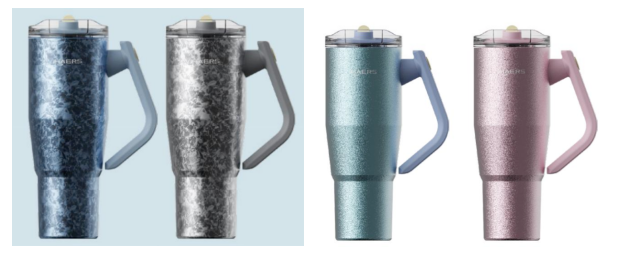
Importantly, the two techniques are not mutually exclusive—they can be combined. For example, Haers offers a hybrid “Powder Coating + Partial UV Printing” solution. This approach uses powder coating for the base layer, ensuring durability and cost efficiency, while selectively applying UV printing on specific areas like the bottle cap or logo zone for personalized accents. This hybrid strategy balances functionality and design, ideal for brands that seek both aesthetic appeal and practical performance.
At Haers, we provide flexible combinations of powder coating, UV printing, and other surface technologies. Rather than locking you into a fixed finish, we support tailored appearance solutions to best fit your brand’s needs.
Powder coating and UV printing offer unique strengths that cater to different product needs and market scenarios. When brand retailers prioritize large-scale production, durability, and cost-efficiency—especially for products used in rugged environments like outdoor or industrial settings—powder coating stands out as the ideal solution. On the other hand, UV printing brings strong advantages for personalized, visually engaging designs, making it particularly well-suited for small-batch runs, limited editions, and products targeting trend-driven consumers.
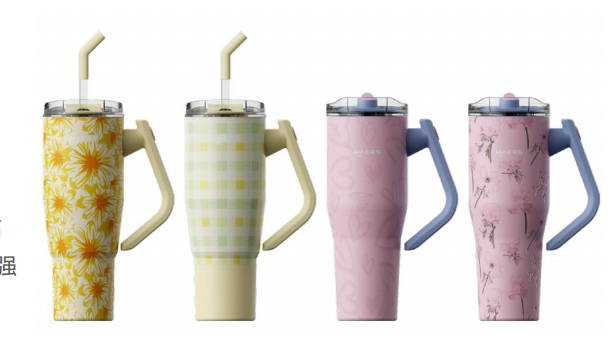
As an experienced water bottle supplier, Haers not only masters both surface treatment technologies but also understands the real-world demands of brand retailers. We tailor our process recommendations based on your product goals and market positioning, helping you strike the right balance between functionality, aesthetics, and budget. By combining the strengths of powder coating and UV printing, Haers helps your brand to deliver products that are both attractive and reliable—driving customer satisfaction while enhancing commercial value.
Related Articles
What is UV ice foaming printing


